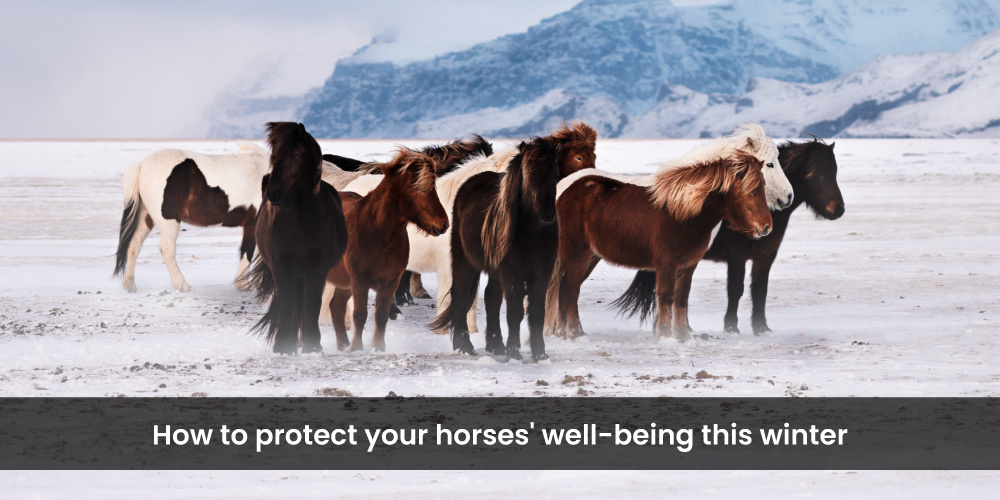With winter approaching, it becomes important for horse owners to take care of their horses as low temperatures can result in chilly muscles, slower-moving joints, and a stiff, uneasy feeling in the horses.
To keep the health of the horses intact, one needs to appropriately take care of them as they are more susceptible to injury due to lowered shock absorption and flexibility with falling temperatures.
A quarter sheet can be added to the winter tack collection. The quarter sheets are going to hang over the rear of the horse and provide warmth for the huge muscles in the hindquarters. Any horse can benefit from quarter sheets, but clipped animals who require more heat can benefit most from them.
A waterproof quarter sheet might be more appropriate for you if you want to ride outside so your horse is shielded from the weather.
Due to the long hair, a horse's coat takes longer to dry in the winter. While their thick coats normally help to keep them warm, they can become a hassle for riders who travel far in the winter. Until their coat is dry, a horse's coat cannot keep them warm during a ride. For this reason, some riders decide to body clip their horses throughout the year. With synthetic rabbit fur, the horse can stay warm by producing little air pockets that trap body heat.
In order to keep the horses warm after a ride, one should throw a fleece rug on the horse, this helps them dry faster by wicking away moisture like sweat.
Since horses are more prone to respiratory diseases and illnesses in the winter because their stables tend to be closed up with no fresh air, we should make sure the riding area is well-ventilated. A thorough warm-up before your ride will keep your horse comfortable the entire time.
While putting on the bridles, breastplates, haltersand martingales, one should make sure of the comfort of the horses as they might feel cold due to the same. One should properly take care of their horses during winters to keep them warm. The health of the horses should be the top priority of all riders. Although the cold makes it difficult to accomplish that aim, it is ultimately well worthwhile. These suggestions can assist you in keeping your horse warm during winter workouts whether you ride outdoors or indoors. Your horse's muscles and joints will be ready for heavier action after a thorough warm-up. Consider including a moisture-wicking fleece rug in your post-ride routine because it's important to keep in mind that your horse won't be warm if they aren't dry.
Other important horse equipment that should be of the finest quality to make your horse feel comfortable during all seasons:
Bridles:
A hackamore, or bitless bridle in some places, is a type of non-biting headgear that uses a noseband to manage a horse. A horse's bridle is customised for them. Without a correct fit, the bridle may cause discomfort for the horse, and a bad fit may cause a lack of control or imprecise communication while riding. All of the designs, which come in a wide variety of names and designs, use a noseband that is intended to provide pressure to the animal's face's most delicate points to direct and control it.
The majority of riding bridles differ from those used for driving horses in a few key ways. The most obvious distinction is that winkers, blinders, or other partial eye covers that limit the horse's peripheral vision are typically present. They sometimes have a monogram or insignia and are embroidered into the cheek pieces of a driving bridle. Winkers can be square, deep-shaped, hatchet-shaped, or round, and they can be positioned so that they are clear of the horse's eye's centre.
To fit the horse's head, each piece of the bridle must have its length customised. There are restrictions on how much may be adjusted in other components of the bridle, therefore many manufacturers offer two to six various basic sizes. The sizes may go by several names, but in the United States and Canada, for little and large animals, respectively, they are frequently referred to as "cob" and "horse," with "pony," "mini," "warmblood," and "draught" sizes appearing sometimes in some designs.
Breastplate
A breastplate, sometimes known as a breast collar, breast strap, or breast girth, is a piece of horse riding gear. It serves to prevent the harness or saddle from sliding back.
It is especially beneficial for riding horses with broad shoulders and a flat rib cage. If a rider's girth or billets fail, it is also a safety feature because the rider will have ample time to halt the horse and get off before the saddle slides off its back or under its belly, which is especially important for cross-country riding. On both English and Western saddles, the breastplate is employed. The western-style hunting armour worn for horse displays consists of thinner leather straps than that used for English riding.
Halter:
A halter is used to lead and restrain the horse. It is applied to numerous kinds of animals. Halters are most frequently related to Equidae animals like horses, donkeys, and mules. On farm animals like cattle and goats as well as other working animals like camels, llamas, and yaks, they are further employed. Despite the existence of dog halters, halters are typically not used on elephants or predators.
Halters are regularly employed as working equipment and frequently have a simple design. To actually lead or tie the animal, a lead line, lead shank, or lead rope is needed in addition to the halter.
Halters are only intended to be used for catching, holding, leading, and tying animals. A halter, as opposed to a bridle, is sometimes used to ride horses. Ordinary stable halters typically don't provide enough leverage for the rider if a horse panics or bolts, making them unsafe to use when riding. It is very dangerous to utilise the lead rope as a single rein linked to the leading ring beneath the jaw.
Martingale:
The "martingale" refers to any of the various tack patterns used to govern the head carriage of horses. Martingales can be seen participating in a wide range of equestrian sports, including driving and riding. Their use is governed by a wide range of rules; in certain disciplines, they are never permitted; in others, they may be used for instruction but not for performances that will be assessed; and in still others, only specific designs may be used in competitions.
The two most popular varieties of martingales, the standing and the running, are used to control the horse's head height and stop the animal from flinging its head up so high that the rider would get slapped in the face by the poll or upper neck.
To get the premium-quality and trustworthy horse tack and equipment, The Ashva is the one-stop-shop for you. They have been into the leather industry since the 1970s and know about every nook and cranny related to leather products. They do free express shipping all over the United Kingdom. To know more, visit www.theashva.com.













